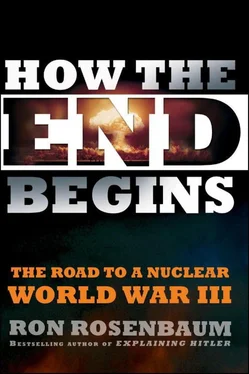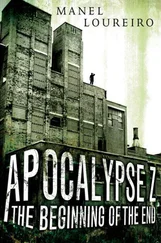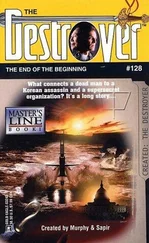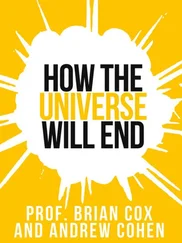Ibid.
Author interview; Ron Rosenbaum, Explaining Hitler (Random House: New York, 1998), pp. 300–18.
Ibid., p. 314.
P. D. Smith, Doomsday Men: The Real Dr. Strangelove and the Dream of the Superweapon (London: Penguin, 2007).
William J. Broad, “Russia Has ‘Doomsday’ Machine, U.S. Expert Says,” New York Times, October 8, 1993, www.nytimes.com/1993/10/08/world/russia-has-doomsday-machine-us-expert-says.html.
Ron Rosenbaum, “The Return of the Doomsday Machine?,” Slate, August 31, 2007, www.slate.com/id/2173108.
David E. Hoffman, The Dead Hand (New York: Doubleday, 2009).
Quoted in Smith, Doomsday Men, p. 434.
Edward R. Landa and John R. Nimmo, “Soil History: The Life and Scientific Contributions of Lyman J. Briggs,” Soil Science Society of American Journal 67, no. 3 (May/June 2003): 681–93, http://soil.scijournals.org/cgi/reprint/67/3/681.
Smith, Doomsday Men, p. 21.
Author interview.
Smith, Doomsday Men, p. 434.
“Russia’s Doomsday Machine,” New York Times, Oct. 8, 1993.
Michael R. Gordon “Tug of War, with a Twist, on Secrets,” New York Times, May 15, 1986, p. B14, www.nytimes.com/1986/05/15/us/tug-of-war-with-a-twist-on-secrets.html. See also “Our Nation’s Nuclear Warning System: Will It Work if We Need It?”, Testimony of Bruce G. Blair before the House Committee on Government Operations, 99th Congress, September 26, 1985, http://armedservices.house.gov/comdocs/testimony/105thcongress/97-3-13Blair.htm.
Author interview.
www.annapolitkovskaya.com/putinsrussia001.htm.
For jailings, Ellen Barry, “Investigation of Jail Death Is Criticized in Russia,” New York Times, April 23, 2010, p. A4, www.nytimes.com/2010/04/23/world/europe/23moscow.html?scp=2&sq=Ellen%20Barry&st=cse.
Statement of Bruce Blair to Government Operations Subcommittee.
www.fas.org/irp/program/collect/rivet_joint.htm.
James Hasik, “The Crash of the Aerial Common Sensor,” January 23, 2006, www.slideshare.net/jhasik/the-crash-of-the-acs.
Jeremi Suri, “The Nukes of October: Richard Nixon’s Secret Plan to Bring Peace to Vietnam, Wired, February 25, 2008, www.wired.com/politics/security/magazine/16-03/ff_nuclearwar.
Ron Rosenbaum, “The Subterranean World of the Bomb,” Harper’s, March 1978, p. 98.
Unedited draft of letter provided to author by Bruce Blair.
Bulletin of the Atomic Scientists 53, no. 6 (November 1997): 23, http://books.google.com/books?id=vgwAAAAAMBAJ&printsec=frontcover&source=gbs_v2_summary_r&cad=0#v=onepage&q&f=false.
The problem of a high-altitude, nuclear airburst-generated electromagnetic pulse (EMP) continues to plague defense planners, particularly those concerned with nuclear command, control, and communications. A July 22, 2004, report of the congressionally established Committee to Assess the Threat to the United States from Electromagnetic Pulse Attack concluded gloomily that there was no way to assess the degree of damage a high-altitude blast—which creates a sudden shock wave of highly charged electronic particles that impact on all metallic (and, obviously, electronic) devices on the surface of the planet beneath it. And that protective measures could only be tested by exploding a high-altitude nuclear weapon—thus in effect must go untested. The problem was first recognized in the 1960s and made widely public in a series by New York Times science reporter William Broad in a 1980 issue of Science magazine. The implications for this continuing unknown factor on all the highly calibrated targeting plans of every nuclear power are obvious: nobody knows whether any given pattern of launches will be disabled completely or to what extent by EMP: Dr. William R. Graham, Chairman, Commission to Assess the Threat to the United States from Electromagnetic Pulse Attack, www.iwar.org.uk/iwar/resources/emp/07-22-2004-emp-hearing.htm.
Walter J. Boyne, Beyond the Wild Blue: A History of the U.S. Air Force, 1947–1997, 2nd ed. (New York: St. Martin’s, 2007), p. 299.
Joe St. Saveur, “Cyber War, Cyber Terrorism and Cyber Espionage, v1.2,” PowerPoint presentation at IT Security Conference, Fargo North Dakota, October 21–22, 2008, slide 15, www.uoregon.edu/~joe/cyberwar/cyberwar.ppt.
Valery E. Yarynich, C3: Nuclear Command, Control, Cooperation (Washington, D.C.: Center for Defense Information, 2003), www.cdi.org/program/document.cfm?documentid=1503&programID=32&from_page=../friendlyversion/printversion.cfm.
See for instance the diagram and description of the Russian nuclear command structure on pp. 151–58.
C3, “fig.37 PERIMETR system,” p. 158.
Author interview, December 9, 2009.
David E. Hoffman, The Dead Hand (New York: Doubleday, 2009), pp. 61–63.
William Bennett Jones, “Operation RYAN, Able Archer 83, and Miscalculation: The War Scare of 1983,” for the University of California, Santa Barbara, International Graduate Student Conference on the Cold War, April 2008, www.wilsoncenter.org/topics/docs/08%2004%2001%20Nathan%20Jones%20Operation%20RYAN%20Able%20Archer%2083%20and%20Miscalculation%20IGSCCW.pdf.
Hoffman, The Dead Hand, p. 95.
Author interview.
F. S. Nyland, “Some Potential Risks at Lower Levels of Strategic Nuclear Weapon Arsenals,” June 1998, U.S. Arms Control and Disarmament Agency, Washington, D.C., www.dtic.mil/cgi-bin/GetTRDoc?AD=ADA348992&Location=U2&doc=GetTRDoc.pdf; Bruce G. Blair, The Logic of Accidental Nuclear War (Washington, D.C.: Brookings Institution, 1993).
“100 Nuclear Wars,” unpublished draft given to author.
Ron Rosenbaum, “A Real Nuclear Option for the Nominees: Averting Accidental Nuclear War in Two Easy Steps,” Slate, April 9, 2008, www.slate.com/id/2191104.
Blair quoted in ibid.
Ibid.
Ibid.
Bruce G. Blair, De-Alerting Strategic Forces (Washington, D.C.: Brookings Institution Press, 2004).
Yarynich, “100 Nuclear Wars,” p. 2.
Michael Graham Richard, “The Risks of Failure of Nuclear Deterrence,” online post, November 26, 2008, http://michaelgr.com/2008/11/26/risks-failure-nuclear-deterrence.
Читать дальше











